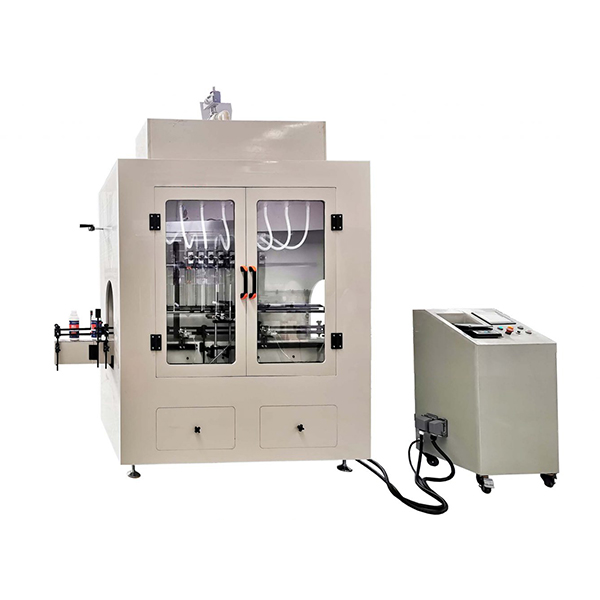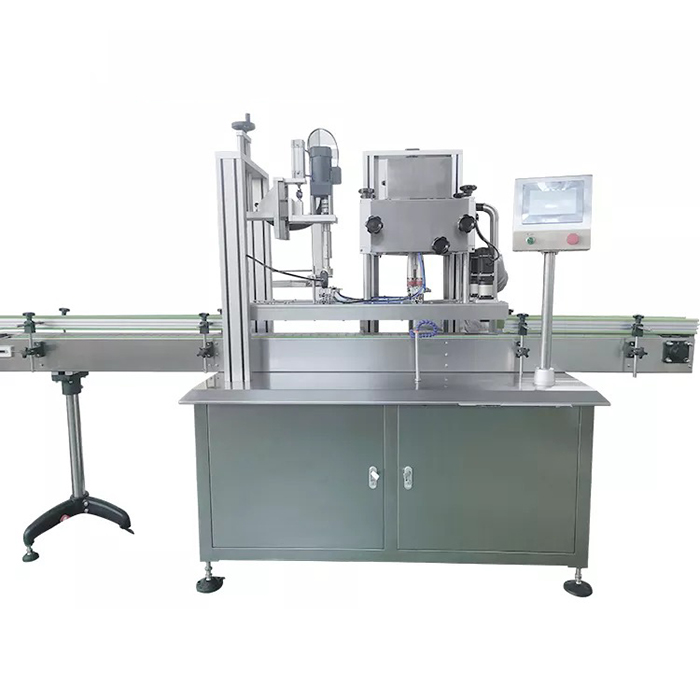
Summary
A corrosive liquid is one that will damage or destroy other substances with which it comes into contact by means of a chemical reaction. Many chemicals commonly used in the laboratory are corrosive or irritating to body tissue. Corrosive liquids (e.g. mineral acids, alkali solutions and some oxidizers) represent a very significant hazard because skin or eye contact can readily occur from splashes and their effect on human tissue generally takes place very rapidly.
If your business deals with filling corrosive liquids into containers, you understand the challenges that can come with finding machinery that can accommodate those liquids. At VKPAK, we are proud to offer corrosive filling machinery, including a corrosion resistant corrosive liquid filling machine. Our corrosive fillers, machined out of HDPE (high density polyethylene), are designed to handle the harsh punishment that comes along with corrosive liquids. The fillers are capable of handling a variety of viscosities, perfect for accommodating a number of different industries’ products.
View VideoSome corrosive chemicals are valued for various uses, the most common of which is in household cleaning agents. For example, most drain cleaners contain either acids or alkalis due to their capabilities of dissolving greases, proteins or mineral deposits such as limescale inside water pipes.

Although environmental concern might affect the sales of some specific products in favor of « natural » cleaning agents, the efficiency benefit remains on the side of more corrosive formulas which will still be around for a long time.
Among this corrosive products, bleach is the one that probably has the most promising future: first, it can enter a majority of households in countries where hygiene level is still under development and where consumers look for cleaning and sanitization functions at an affordable cost; second, it meets the expectations of households affected by a loss of purchasing power by offering a multi-functional solution that favorably replaces different task-specific cleaning products.
For all these reasons, the future of corrosive household cleaning products seems not blurred enough to stop considering their manufacturing on the long term.
Auto Corrosive Fillers also include a full digital color touch screen display with job memory, no bottle no fill, step fill or all fill modes, and total bottle counter with on the fly adjustability. The systems are easy to set up, operate, and adjust with minimal training.
Recommended products for this machine Disinfectant, Acid, Bleach, Ammonia, Brine, Salt solution, Caustic liquid, Alcohol, Insect pesticide, Solvent, Alcohol etc.
Construction Material Considerations for Filling Equipment
Filling machines, commonly used in the packaging industry, are typically constructed with stainless steel, owing to its robustness and reliability. Stainless steel demonstrates excellent resistance to most products and environmental conditions. However, certain projects involve the handling of corrosive substances like acids, bleaches, and other liquids that can degrade steel and other metals. In such cases, alternative materials are utilized to enhance the lifespan of filling equipment and minimize wear and tear on the packaging line.
Unique Interactions and Vulnerabilities of Filling Machines
Unlike rinsing or capping machines, filling machines have a distinct characteristic: they directly interact with the product being packaged. These liquid fillers are responsible for transferring the product along a pathway and into the bottle. Consequently, filling equipment is particularly susceptible to wear and tear caused by the properties of the product itself. Not only does the product come into contact with specific parts of the filling machine, but the likelihood of drips and accidental spills is also higher at the filling stage compared to other areas on the packaging line. To address this, filling machines for corrosive products, such as acids and bleaches, can be manufactured using high-density polyethylene (HDPE).
Corrosion-Resistant Filling Machines and their Features
Corrosion-resistant filling machines, similar to their stainless steel counterparts, incorporate all the essential features and options. The key distinction lies in the use of plastic materials for construction. These automated filling machines offer control through programmable logic controllers (PLCs) and user-friendly touchscreen operator interfaces. They can be designed to accommodate various filling principles, utilizing two to sixteen fill heads to meet production demands. Corrosion-resistant filling machines can be equipped with different indexing types, including pin indexing, starwheel indexing, or screw indexing.
The Role of Automatic Conveyors in Packaging Machinery
Automatic packaging machinery necessitates the use of conveyors to facilitate container movement across different packaging stages. Most automatic corrosion-resistant filling machines include high-density polyethylene (HDPE) power conveyors to provide additional protection against premature wear and potential breakdowns in the packaging line. In some cases, the HDPE conveyor may span the entire length of the packaging system to safeguard against spills or drips.
Custom Solutions and Equipment Options
While filling machines primarily require corrosion-resistant materials, other packaging equipment that doesn't directly interact with the product may still be manufactured using stainless steel. However, for highly aggressive products or environments, alternative HDPE equipment, venting options, or customized solutions can be provided. It's important to note that even if your product is incompatible with metallic components, there are efficient options available.
Contact Us for More Information
If you require corrosion-resistant liquid filling machines or wish to explore other equipment options, please don't hesitate to reach out to us. We are available to assist you at any time and provide further information tailored to your specific needs.









